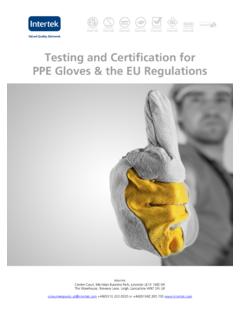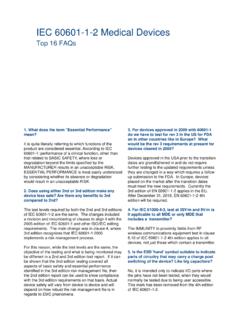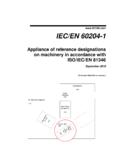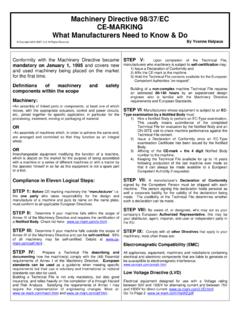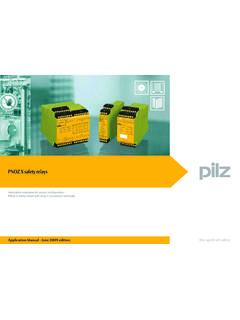Transcription of A Guide to Low Voltage and Machinery Directive …
1 intertek 545 E. Algonquin Rd. Arlington Heights, IL 60005 1-800-WORLDLAB A Guide to Low Voltage and Machinery Directive compliance requirements A Guide to Low Voltage and Machinery Directive INST200-10 INTRODUCTION Manufacturers that intend to sell their products in European Union markets must comply with the Low Voltage Directive (LVD) 2006/95/EC, which seeks to ensure that electrical equipment within certain Voltage limits both provides a high level of protection for European citizens and enjoys a single market in the EU. The Machinery Directive (MD) was established to permit the free movement of Machinery within the EU market. Manufacturers of equipment that fall under the scope of the Directive , such as grinding machines, lathe machines and packaging machines, must issue a Declaration of Conformity (DoC) in order to sell their products in the EU.
2 This white paper gives you a thorough understanding of the key elements of the Low Voltage Directive and the Machinery Directive . The Directives are legal documents (laws) issued on the authority of the Council of the EU and adopted by all member countries. They create a uniform level of requirements and regulations for all EEA members (Harmonisation of legal requirements in the member states). The Directives facilitate the free movement of goods within EU. There are many directives like ATEX, RTTE, PED, PPE, GAD, LVD, and MD. This focus of this white paper is on: Low Voltage Directive (LVD) 2006/95/EC Machinery Directive 2006/42/EC A Guide to Low Voltage and Machinery Directive INST200-10 ELECTRICAL SAFETY - LOW Voltage Directive The Low Voltage Directive (LVD) 2006/95/EC seeks to ensure that electrical equipment within certain Voltage limits both provides a high level of protection for European citizens and enjoys a Single Market in the European Union.
3 The Directive covers electrical equipment designed for use with a Voltage rating of between 50 and 1000 V for alternating current and between 75 and 1500 V for direct current. It should be noted that these Voltage ratings refer to the Voltage of the electrical input or output, not to voltages that may appear inside the equipment. The LVD consists of sixteen articles and Five Annexes The LVD is one of the oldest Single Market Directives and, although it was written before the introduction of the "New" or "Global" Approaches to such legislation. However, in broad terms, it does characterize both by providing a conformity assessment procedure to be applied to equipment before being placed on the Market and Essential requirements (ERs), which such equipment must meet either directly or by means of, harmonized standards.
4 For electrical equipment within its scope, the Directive provides the requirements with respect to health and safety covering all risks, thus ensuring that electrical equipment is safe in its intended use. The manufacturer is responsible for performing the conformity assessment, meaning no third-party intervention is required. So-called notified bodies, however, may provide reports in response to a challenge by a national authority regarding the conformity of the equipment. The principal elements of the safety objectives referred to in paragraph 1 are listed in Annex I. GUIDELINES ON THE APPLICATION OF LVD 2006/95/EC What are the conformity assessment procedures to be applied under LVD 2006/95/EC? Article 8 and Annex IV of the Directive describe the procedure by which the manufacturer or its authorized representative established in the EC ensures and declares conformity of the electrical equipment with the provisions of the Directive .
5 This procedure includes three main elements. 1. CE marking. Before it is placed on the market, the electrical equipment must have the CE marking affixed. Only the manufacturer or their authorized representatives established in the EC are authorized to affix the CE marking. A Guide to Low Voltage and Machinery Directive INST200-10 2. Technical documentation. Before a product is placed on the market, the manufacturer compiles the technical documentation, which makes it possible to assess whether the electrical equipment complies with the requirements of the Directive . 3. Declaration of conformity (DoC). The manufacturer or its authorized representative established in the EC are also required, and are the only ones authorized, to issue in writing a DoC (see below) before placing the product on the market.
6 For cases in which no standards within the meaning of the Directive have been applied, the manufacturer must provide within the technical documentation a description of the solutions adopted to satisfy the safety requirements of the Directive . In case of challenge by the authorities in charge of market surveillance, a report in the sense of Article is considered an element of proof. In the event that conformity is challenged, Article allows manufacturers to submit a report issued by a notified body as evidence that the electrical equipment complies with the safety objectives (Article 2 and Annex I). In certain cases, the manufacturer or its authorized representative established within the EC may ask in advance for a report to be issued by a notified body in accordance with the procedure provided for in Article 11, and to keep it together with the technical documentation.
7 The availability of such a report would make matters easier and speedier in the event of a challenge by the authorities. The main function of Article is to provide the conditions most favorable to progress and dynamism in the electrotechnical industry. It facilitates the marketing of high-tech electrical equipment, which cannot benefit from the support of any technical standards because such standards are often created after the development of a technical innovation. What is the purpose of CE marking? CE marking declares conformity of electrical equipment with the essential requirements and conformity assessment procedures established under the LVD and all other directives applicable to it. CE marking provides an understanding that safety of individuals and protection of environment have been considered in the design of equipment.
8 It is not a mark of quality, nor is it a type mark. CE marking is the basic mandatory requirement to enter the EU. It is a form of legal security in the court of law, which means if there is an accident due to the A Guide to Low Voltage and Machinery Directive INST200-10 misuse of the product, then your technical construction file (TCF) and DoC will shield you from legal process. When product is marked with CE, it is understood that it complies with all applicable directives. CE helps the manufacturer to freely move the product into the entire EU market, which is twice as large as the North American market. Where should the CE marking be affixed? The manufacturer or its authorized representative established in the EC must place the CE marking on the electrical equipment.
9 If it is not possible to place the mark on the product, then it must be placed on the packaging, on the instructions for use or on the guarantee certificate. The CE conformity marking must be affixed visibly, legibly and indelibly. What constitutes CE noncompliances? Failure to satisfy the essential requirements Incorrect application of the harmonized standards Failure to produce a TCF Failure to provide a DoC Incorrect application of CE mark No application of CE mark Missing or incomplete instructions (including the necessary translation) What must be included in the technical documentation? The technical documentation must include details of the design, manufacture and operation of the electrical equipment, to the extent that these details are necessary to assess the conformity of the electrical equipment with the requirements of the Directive .
10 The documentation must contain: A general description of the electrical equipment, design and manufacture drawings, as well as diagrams of components, subassemblies, circuits, etc. Descriptions and explanations that are necessary to understand the aforementioned drawings and diagrams, as well as the operation of the electrical equipment A list of the standards used, in full or in part, and a description of the solutions employed to meet the safety aspects of this Directive when standards have not been applied The results of design calculations and of checks performed Test reports established either by the manufacturer or a third party A Guide to Low Voltage and Machinery Directive INST200-10 Who must keep the technical documentation and where?






